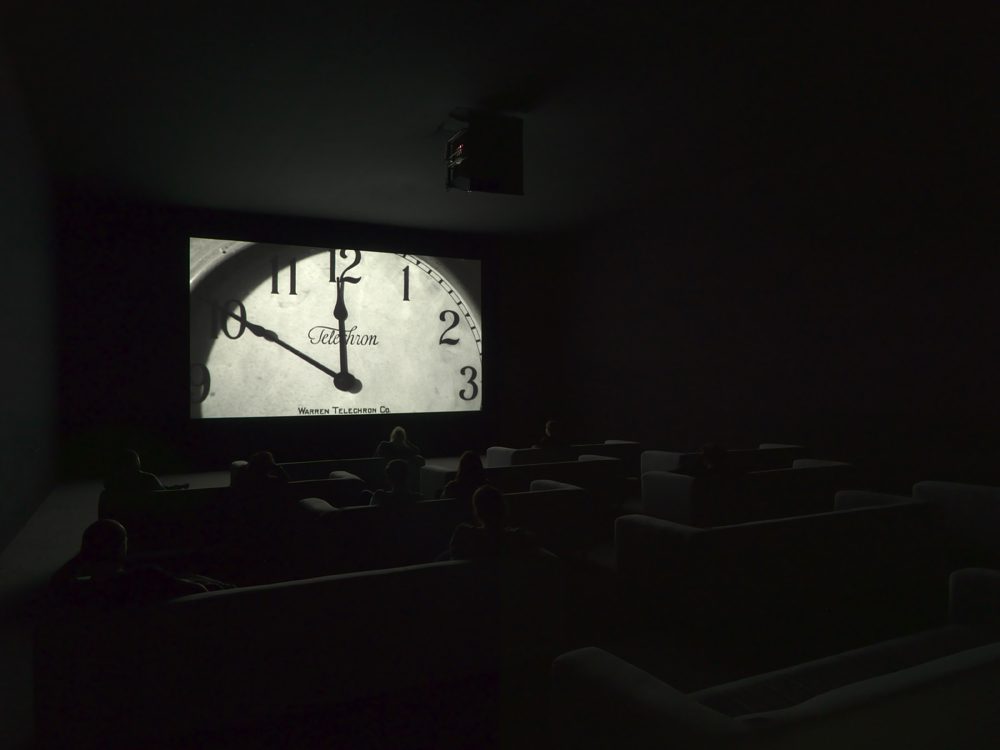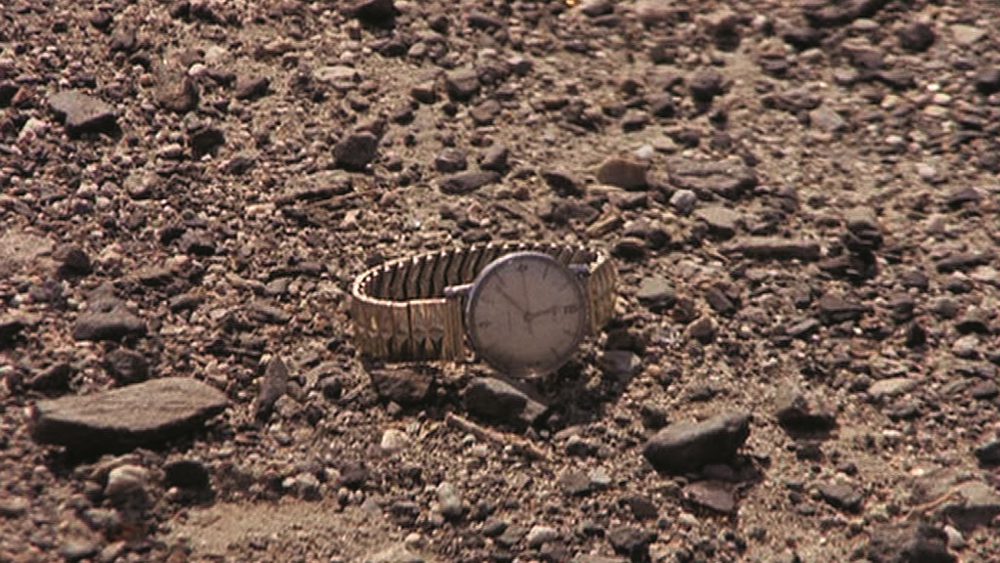Minding “The Clock”: Christian Marclay at the Contemporary Arts Center
John d’Addario immerses himself in Christian Marclay’s 24-hour video installation, presented by Prospect New Orleans at the Contemporary Arts Center.

Installation view of Christian Marclay’s The Clock, 2010, at Paula Cooper Gallery, New York. Courtesy the artist and Paula Cooper Gallery, New York.
Do not squander time. That is the stuff life is made of.
Those words appear on a sundial—in a clip from Gone with the Wind—that shows up around 3:35 pm in Christian Marclay’s The Clock, 2010. Presented by Prospect New Orleans in partnership with the Contemporary Arts Center (CAC) this month—five years after winning the Golden Lion at the 2011 Venice Biennale—The Clock has achieved practically universal acclaim as a touchstone of recent contemporary art.
Having The Clock arrive in New Orleans this long after its premiere at White Cube in London (and after all your friends in bigger cities have seen it already) has its advantages. During its opening week at the CAC, there was never a problem finding a seat on one of the twelve artist-mandated Ikea Klippan sofas in the installation—as opposed to the long lines with which viewers in other cities, like New York and San Francisco, had to contend. (The video installation is currently open to the public during regular CAC hours, and will also be shown in 48-hour continuous screenings over two weekends this month.)
“Epic” is, of course, a much overused word. But it comes close to describing the still astounding scale of Marclay’s project, in which nearly every moment of the day is synchronized to its depiction on screen in real time. Over a 24-hour loop, its more than 10,000 individual fragments span the entire range of filmic vernacular, from early silent movies to big-budget 21st-century Hollywood action spectacles.
That said, the most immediately engaging aspect of The Clock isn’t so much the sheer agglomeration of source material as it is the visual and sound editing and the continuity between the individual segments. A phone that rings in one scene is answered in the next. A character walks out a door and emerges from an entirely different one, having changed identities (and film stock) en route. Overlapping sound cues and visual echoes between clips create a constant and delicately modulated tension. The effect is simultaneously disjointed and oddly cohesive. It contributes to The Clock’s addictive quality: You’re constantly waiting for each micronarrative to resolve itself somehow, even though most of them never reach their ending or achieve any resolution at all.
Despite (or maybe because of) its disparate source material, The Clock is not without its recurring locations and faces. The effects of time are both emphasized and erased: Instantly recognizable actors like Al Pacino and Jack Nicholson age and become young again as the hours pass. Unsurprisingly, London’s Big Ben—the most famous clock in the world—figures prominently throughout the piece. So does the four-sided clock on top of the information booth in the center of New York’s Grand Central Station. In fact, save for the occasional digital clock or pre-2010 cellphone, most of the timepieces in The Clock are analogue ones.
As such, The Clock reveals a lost universe of gestures: opening a pocket watch, winding a wristwatch, adjusting the pendulum of a grandfather clock, synchronizing timepieces before a bank heist. And smoking; Marclay once called a burning cigarette “the twentieth-century symbol of time.”

A still from Christian Marclay’s The Clock, 2010. Single-channel video with stereo sound. Courtesy the artist and Paula Cooper Gallery, New York.
Some viewers have detected certain rhythms in the proceedings. The Wikipedia entry for The Clock, for example, includes a kind of schedule describing actions that take place in the piece during different hours of the day:
“After midnight, characters go to bars and drink. Some seek intimacy while others are angry to have been awakened by the phone…At around 7 a.m., characters are shown waking up. From 9 a.m. to noon, they eat breakfast and have wake-up sex.”
But it soon becomes clear from watching the piece for any duration that events in The Clock aren’t limited to any particular time: People sleep in until late morning, drink throughout the afternoon and early evening, and have sex pretty much whenever they feel like it. Imminent physical peril and death—by illness, accident, ticking bomb, or dangling high over a city street while clinging to the hour hand of a giant clock—are also motifs and can happen at any moment.
While certain times (like noon and midnight) might arrive with greater dramatic weight, The Clock doesn’t privilege one part of the day over any other. Each moment contributes equally to Marclay’s temporal construction. As a result, The Clock creates an ideal condition for mindful viewing: an active and unbiased awareness of each present moment as it occurs.
Viewed as a sort of mindfulness exercise, The Clock is remarkably effective in continually keeping you aware of and engaged in the current moment. (It’s so compelling that many viewers have described watching the piece for far longer than they had intended: It seems there’s no better way of losing track of time than having it constantly displayed in front of you.) And far from just being an extended memento mori as several critics (and Marclay himself) have described it, The Clock provides the comforting illusion—despite whatever that sundial says—that time is an inexhaustible resource. The piece will still be playing after you leave and even after the museum closes, looping in an empty room.
But perhaps reading too much into The Clock is beside the point. Like the films it draws upon, it exists primarily as spectacle, something to be experienced and enjoyed. A few minutes before that sundial appears in the video, a classroom of children sings Irving Berlin’s “Song of the Metronome” (from the 1939 Sonja Henie vehicle Second Fiddle), and the lyrics hint at what The Clock may ultimately be all “about”:
Listen to it telling you that life is sublime,
Life is sublime if you just take your time...
Better to be late than to not arrive—
Tick-tock, tick-tock—
Four o'clock has gone but you still have five
Tick-tock, tick-tock
Maybe we don’t really have to worry about squandering time after all.
Editor's Note
Christian Marclay’s The Clock is on view through December 4, 2016, at the Contemporary Arts Center (900 Camp Street) in New Orleans. The Clock is open for extended hours from Friday, November 18 at 5 pm to Sunday, November 20 at 5 pm and from Friday, November 25 at 5 pm to Sunday, November 27 at 5 pm.



